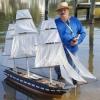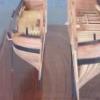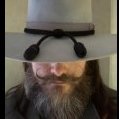Supplies of the Ship Modeler's Handbook are running out. Get your copy NOW before they are gone! Click on photo to order.
×

dcicero
-
Posts
266 -
Joined
-
Last visited
Reputation Activity
-
 dcicero reacted to dgbot in Teazer by dgbot - FINISHED - CARD - Blockade Runner
dcicero reacted to dgbot in Teazer by dgbot - FINISHED - CARD - Blockade Runner
Thanks for the comment Keith. I go back to Iowa City Monday for a full day of PET scans. Then Friday to see the Doctor. They are already trying to schedule a bed in the isolation ward for my first tranplant. If available I will be there for a full month. I needed the weeks after my cell extractions in order for my. However it took me several days to recover from that small trip but it was worth it.
I operated the sail boat and really enjoyed myself. It is nice to have friends who care.
David B
-
 dcicero got a reaction from Ryland Craze in How to Taper Masts?
dcicero got a reaction from Ryland Craze in How to Taper Masts?
I did a presentation on masts and spars for the club I belong to. (Shameless plug for the The Nautical Research and Model Ship Society of Chicago.) I've attached the presentation. I use a small lathe made by Harbor Freight Tools, a digital caliper and a file.
Hope this helps!
Dan
Masts and Spars.pdf
-
 dcicero got a reaction from JerryTodd in Constellation 1856 by JerryTodd - 1:36 scale - RADIO - First Class Sloop of War
dcicero got a reaction from JerryTodd in Constellation 1856 by JerryTodd - 1:36 scale - RADIO - First Class Sloop of War
Jerry:
Your Constellation is looking great. I'm following your progress with great interest!
And your wargame collection -- visible in the background of several of your pictures -- looks great too. Lots of overlap with my collection.
Dan
-
 dcicero reacted to JesseLee in Scottish Maid by JesseLee - FINISHED - Artesania Latina - 1:50
dcicero reacted to JesseLee in Scottish Maid by JesseLee - FINISHED - Artesania Latina - 1:50
Now forming the strip of brass that will hold the bell & attach to the stanchion. Then used very thin wire to form in one piece a loop holing the bell on, the handle & the ...um....ringer? -for the life of me I can't remember what you call that thing! . I also added a short cord hanging off the handle for pulling. The picture doesn't show it well but it's there.
I plan on making some handspikes to go with it later. Gotta watch it- already trying to use the hand too much too soon
-
 dcicero got a reaction from dgbot in Teazer by dgbot - FINISHED - CARD - Blockade Runner
dcicero got a reaction from dgbot in Teazer by dgbot - FINISHED - CARD - Blockade Runner
David:
Your work inspired me to look at some of the old paper models I have. Luisa had some health problems recently and I just didn't have the mental energy to work on the Longboat. Paper modeling was just the thing.
I printed out this model of the Bell Aircraft X-1, aka Glamorous Glennis. This was the aircraft in which Chuck Yeager broke the sound barrier back in 1947.
Took just a few modeling sessions, maybe four in all. It turned out alright, although I need to do a better job touching up the seams. Tried the colored pencil route, but the kids just didn't have exactly the right shade of orange!
Hope you're feeling better. We all missed you in Manitowoc.
Dan
-
 dcicero reacted to dgbot in Teazer by dgbot - FINISHED - CARD - Blockade Runner
dcicero reacted to dgbot in Teazer by dgbot - FINISHED - CARD - Blockade Runner
Unfortunately I was preoccupied with being at the University of Iowa and the kind people at the Hope Lodge so I did not have much energy to get much done. But I am now back. I finally started on the bow. The crane, anchor and chain. Since I am working with just the stock itself I did the best I could. Though this would have been easier with other material. I cut out the sheet and glued it up
This time around I soaked the pieces in CA in order to reinforce them. And once cut out I used a marker to touch up the color. Note to self always keep a pack of markers handy.
By using CA I was able to make everything piable enought to glue to the hull. For this I used white Elmers.
So far so good.
David B
-
 dcicero reacted to jablackwell in Sultana by jablackwell – FINISHED - Model Shipways – Scale 1:64 - first ship build
dcicero reacted to jablackwell in Sultana by jablackwell – FINISHED - Model Shipways – Scale 1:64 - first ship build
The model is almost complete now. I have some finishing touches to add: some coils here and there and some black paint dabs to cover up some shiny glue spots. All in all, I am pretty happy with the whole thing with exception of the stern. That part kept me in trouble for most of the project, but I am very happy with wood filler and its ability to mask some pretty tremendous errors. The rigging was a lot easier than I had anticipated. I am still looking for a good pair of long reach tweezers with flat grabs which can get the threads from a distance. I have found that most tweezer makers have pointy tips and a very small region that will grab thread well. I am not even sure how to describe what I am looking for,,,,,
So, some images....
I want to thank all of you for helping out so much, some directly and some without even knowing it. Your posts and information shared on this site have been a real wealth of input and knowledge. It is greatly appreciated!
My next project is already on the bench: the Kate Cory brig. This is a little larger and more detailed. I am looking forward to the added detail work, and this time, a coppered hull. I will try to post more than I did with this model... now that I know this site exists! The Cory will be the last solid hull work for me. I am planning to go to plank builds next and want to get through a build of the Surprise. We'll see.
~johnb
-
 dcicero reacted to JesseLee in Scottish Maid by JesseLee - FINISHED - Artesania Latina - 1:50
dcicero reacted to JesseLee in Scottish Maid by JesseLee - FINISHED - Artesania Latina - 1:50
The instructions show to cut off the bowsprit at the same angle as the deck & glue it down on the deck surface. As usual that's not good enough for me. I'd never get it right & I also know it would not be secure enough. So I drilled & filed a hole for the bowsprit & glued it in. Had to do some minor patching on the deck planking around the hole but the windlass will hide it when it is in place.
-
 dcicero reacted to JesseLee in Scottish Maid by JesseLee - FINISHED - Artesania Latina - 1:50
dcicero reacted to JesseLee in Scottish Maid by JesseLee - FINISHED - Artesania Latina - 1:50
Tying & seizing blocks. Very difficult for me to do. Maybe this will be easier after the surgeries. For some reason the camera makes the paint look way more rough & crude than it looks by eye.
-
 dcicero reacted to JesseLee in Scottish Maid by JesseLee - FINISHED - Artesania Latina - 1:50
dcicero reacted to JesseLee in Scottish Maid by JesseLee - FINISHED - Artesania Latina - 1:50
The only thing I'm doing different is the first piece around the deadeye I am making shorter & adding an extra link in the assembly. I formed the first wire around the deadeye. After I'm sure it is shaped as best as I can get it I take the deadeye back out, apply CA glue, put it back together & crimp it with pliers to dry tight. I glue the junction point with CA glue & seize the area with some thin black thread. I glue the thread, touch up with some black paint. This actually holds very well & does not pull apart. After I finish this first step I will begin to put the other links together.
-
 dcicero reacted to JesseLee in Scottish Maid by JesseLee - FINISHED - Artesania Latina - 1:50
dcicero reacted to JesseLee in Scottish Maid by JesseLee - FINISHED - Artesania Latina - 1:50
I don't have soldering supplies so I wasn't sure how I was going to go about doing the chain plate assembly. Saw in Keith's log about a log of Ferit KUTLU's Berlin build. I looked it up & liked his ideas on how to do this without soldering. The pics below are from his log that I will use to make mine.
-
 dcicero got a reaction from Ryland Craze in 18th Century Longboat by dcicero - FINISHED - Model Shipways - 1:48 - Tri-Club
dcicero got a reaction from Ryland Craze in 18th Century Longboat by dcicero - FINISHED - Model Shipways - 1:48 - Tri-Club
Not a tremendous amount of progress to report, but some...
I've got the seats and the locker lid installed.
This whole operation was pretty straightforward. I fitted the seats in place by cutting the notches needed to fit around the frames.
Then installed them.
There was one tricky part of this process. The seat, locker lid and the thin part of the locker lid that butts up against the transom: four pieces. There isn't much gluing surface to work on the locker lid, so dry fitting all four pieces gave me a little trouble. I installed the seats first because, once in place, I would be able to concentrate on the locker lid.
The cut piece in the kit is substantially bigger than it needs to be. As can be seen here, the distance from the transom to the end of the locker is only about 8/32".
And the locker lid -- with the stern piece attached -- is about twice that wide.
So cutting that piece down to size and maintaining the proper angle on the edges is a little tricky.
Once in, I just painted it.
Then an interesting part of the project came up. I was trying to figure out how to make the hinges described in the instructions. Seemed pretty simple: use the narrow brass strip and some 28 gauge wire and, well, just make them.
But I thought that 28 gauge wire was a little narrow and the brass strip was tiny too. Wouldn't it look too small? I figured I could make some pretty convincing hinges, so I started.
Here are all the materials.
I started by cutting two little pieces of brass strip and putting a small piece of 20 gauge wire between them. I glued them together with CA and then cut out the assembly to make the hinge. I thought it looked good.
This is a really small hinge.
But when I put it on the boat, it looked huge an out-of-scale.
So I made some smaller hinges. That process was simpler. I just used the CA glue to attach a piece of 28 gauge wire to the narrow brass strip. I made two of those.
Those small hinges look a lot closer to scale. Now we're talking about some really, really small hinges.
I had to paint them flat black because putting them in the brass black with the CA glue on them, I figured, would mean the glued parts would remain brass and the parts without glue would be blackened.
Here they are.
Now I just need to attach them to the boat.
Dan
-
 dcicero got a reaction from Aussie048 in 18th Century Longboat by dcicero - FINISHED - Model Shipways - 1:48 - Tri-Club
dcicero got a reaction from Aussie048 in 18th Century Longboat by dcicero - FINISHED - Model Shipways - 1:48 - Tri-Club
Time for another update...
I took David's suggestion and cut the holes for the sheaves before turning the mast down to its final dimensions. Here's a look at the mast with the holes drilled.
Then I turned the mast down the rest of the way. Here's the mast laid on the plans.
Finally, I cut the grooves between the holes to simulate the sheaves.
The instructions say the leave tenons at the top and bottom of the mast. I'm going to try to do that, but, at the top, there isn't a great deal of extra room. I might just cut the mast a little long and fit the extra into the ball truck. At the bottom, there's plenty of room and the tenon shouldn't be a problem.
Once the mast was done, I turned my attention to the wide thwart and the mast hoop. I've found my new favorite modeling material: Birchwood Casey Brass Black!
I started by cutting and forming the brass strip. I know that's a little out-of-order. I should have annealed it first, but it seemed to work alright.
Then I passed the formed strip through a flame to get rid of any coating that might be on there.
Here's what the formed pieces looked like, pre-blackening.
I dunked the formed pieces in isopropyl alcohol, then rinsed them with water, then put them in the Birchwood Casey ... and watched the magic!
Here's the ironwork installed.
Looks good, right?
Right.
So now it's time for something tragic to happen.
I drilled the holes for the four belaying pins. I painted the pins using Polly S acrylic Wood Tan. (Just happened to have some of that around.) There is not a lot of room for these four pins. My thwart must be a little more narrow than Chuck's because his look like they have more room between them than mine. I hope this doesn't make rigging too difficult.
Then it was time to install the completed assembly in the boat. Measure, cut, fit, glue ... and here's the result.
Anyone notice anything odd? How about a closer look?
That's right! It's in BACKWARDS!
I was really impressed with how good this whole thing looked and then I looked in the instruction book again. BACKWARDS! I installed the stupid thing BACKWARDS! Measure twice! Cut once! Arrrrrrgh!
Once again, I was glad I was using white glue on this model because removing the thwart was fast and easy. Ken Quast, another model builder in our club, told me, when he messes up a part, it's usually faster to just make another one rather than try to fix a mistake. I really considered that, but this assembly took me the better part of a week to do. I thought I'd give fixing it a try before pitching it and doing it again.
I put a couple of little patches on the notches I'd cut, then I cut new ones. I sanded the whole assembly and, although you can see where the old notch was, it will probably be hidden when the knees are installed.
So there it is. All the thwarts are installed. I need to hit them with the Watco's Danish Wood Oil and then on to the inboard details.
Dan
-
 dcicero got a reaction from fnkershner in 18th Century Longboat by dcicero - FINISHED - Model Shipways - 1:48 - Tri-Club
dcicero got a reaction from fnkershner in 18th Century Longboat by dcicero - FINISHED - Model Shipways - 1:48 - Tri-Club
Last week was full of distractions and I got very little done on the longboat ... but what I did get done looks pretty good.
The forward platform went in just fine.
Making the risers was also pretty straightforward. I didn't complicate the scribing of the grooves. I just ran an awl against the edge of a ruler and scribed them in. A couple of passes was all it took to get some good looking grooves in them. (I did have one riser look a little more "fuzzy" than the other one. Don't know why, but it'll all sand out.)
The amount of edge bending needed was a little more than I had initially anticipated. It took two trips to the glass plate to get enough bend in the plank to get it to sit correctly against the frames with a consistent measurement from the top of the cap rail.
When I went to install the risers, I found that the forward platform was a little too high. When it was just the template sitting there it looked fine, of course. That operation wasn't that tough. I just made it a little smaller and sanded the frames a little bit more.
Once the platform was back in, the risers went in without a problem.
Then it was time to put in the locker bulkhead. Following the instructions, I made a template. The nice thing about using templates is the ability to alter them quickly and easily. I started out tracing the frame from the plans and then gluing that outline to a piece of cardstock. I cut out the template and found it was far too large to fit in the space behind the frame, so I cut it down ... too much. That was no problem because I just added another layer of cardstock and added in what needed to be replaced. That worked great.
Then I cut a piece of basswood to size and fitted it in place.
Now on to making the thwarts!
Dan
-
 dcicero got a reaction from flying_dutchman2 in The First Royal Dutch Yacht Mary by flying_dutchman2 - FINISHED - Mamoli - 1646
dcicero got a reaction from flying_dutchman2 in The First Royal Dutch Yacht Mary by flying_dutchman2 - FINISHED - Mamoli - 1646
The flags look great, Marc.
I think if you hit them with a little Dulcoat, they'll lose that "too bright" look.
Sometimes, I think people project a modern sensibility on prior centuries. This happens all the time with views of the American Civil War. Millions of photos exist from the Civil War ... all in black-and-white, giving the impression that things were not very colorful back then. In fact, the opposite was true. They loved colorful things back then as much as we do now and sailors painted their ships to impress! Bright colors were used, but on a model they need to be toned down a little to make them look properly to scale and not like toys.
Dan
-
 dcicero got a reaction from dgbot in The First Royal Dutch Yacht Mary by flying_dutchman2 - FINISHED - Mamoli - 1646
dcicero got a reaction from dgbot in The First Royal Dutch Yacht Mary by flying_dutchman2 - FINISHED - Mamoli - 1646
The flags look great, Marc.
I think if you hit them with a little Dulcoat, they'll lose that "too bright" look.
Sometimes, I think people project a modern sensibility on prior centuries. This happens all the time with views of the American Civil War. Millions of photos exist from the Civil War ... all in black-and-white, giving the impression that things were not very colorful back then. In fact, the opposite was true. They loved colorful things back then as much as we do now and sailors painted their ships to impress! Bright colors were used, but on a model they need to be toned down a little to make them look properly to scale and not like toys.
Dan
-
 dcicero reacted to flying_dutchman2 in The First Royal Dutch Yacht Mary by flying_dutchman2 - FINISHED - Mamoli - 1646
dcicero reacted to flying_dutchman2 in The First Royal Dutch Yacht Mary by flying_dutchman2 - FINISHED - Mamoli - 1646
After seeing "egkb" serving jig, I decided to make one as well. For this idea to materialize I give ALL the credit to him.
All items except the LEGO gears I already had in my collection or scavenged from other items and all pictures give measurements and descriptions.
Purchased 2 sets of LEGO gears from eBay. I did 2 sets in case I made mistakes with enlarging the hole for pulling the rods through (and I did make mistakes). I used 4 - 40 tooth gears for connecting the rod and tubing together and 2 - 16 tooth gears to act as nuts on the brass tubing.
The brass tubing is from my R/C pile and the metal rod is from an old cloth hanger. Basswood is used for this jig.
Attached LEGO gears. Top gear has a brass tube for serving rope and the bottom gear holds the metal rod. Same setup on the opposite side of the jig.
I cut up 2 - 1/2" brass tubing to act as a sleeve for the metal rod. This was hammered into the 2 holes where the rod goes through for a tight fit. The metal rod turns smoothly.
For serving roping can be pulled through the brass tubing. This is essential if the rope is longer than 12" inches.
Optional alligator clip attached to a rod which fits into the brass sleeve for serving blocks, etc.
Picture says it all.
-
 dcicero got a reaction from Aussie048 in 18th Century Longboat by dcicero - FINISHED - Model Shipways - 1:48 - Tri-Club
dcicero got a reaction from Aussie048 in 18th Century Longboat by dcicero - FINISHED - Model Shipways - 1:48 - Tri-Club
Not a tremendous amount of progress to report, but some...
I've got the seats and the locker lid installed.
This whole operation was pretty straightforward. I fitted the seats in place by cutting the notches needed to fit around the frames.
Then installed them.
There was one tricky part of this process. The seat, locker lid and the thin part of the locker lid that butts up against the transom: four pieces. There isn't much gluing surface to work on the locker lid, so dry fitting all four pieces gave me a little trouble. I installed the seats first because, once in place, I would be able to concentrate on the locker lid.
The cut piece in the kit is substantially bigger than it needs to be. As can be seen here, the distance from the transom to the end of the locker is only about 8/32".
And the locker lid -- with the stern piece attached -- is about twice that wide.
So cutting that piece down to size and maintaining the proper angle on the edges is a little tricky.
Once in, I just painted it.
Then an interesting part of the project came up. I was trying to figure out how to make the hinges described in the instructions. Seemed pretty simple: use the narrow brass strip and some 28 gauge wire and, well, just make them.
But I thought that 28 gauge wire was a little narrow and the brass strip was tiny too. Wouldn't it look too small? I figured I could make some pretty convincing hinges, so I started.
Here are all the materials.
I started by cutting two little pieces of brass strip and putting a small piece of 20 gauge wire between them. I glued them together with CA and then cut out the assembly to make the hinge. I thought it looked good.
This is a really small hinge.
But when I put it on the boat, it looked huge an out-of-scale.
So I made some smaller hinges. That process was simpler. I just used the CA glue to attach a piece of 28 gauge wire to the narrow brass strip. I made two of those.
Those small hinges look a lot closer to scale. Now we're talking about some really, really small hinges.
I had to paint them flat black because putting them in the brass black with the CA glue on them, I figured, would mean the glued parts would remain brass and the parts without glue would be blackened.
Here they are.
Now I just need to attach them to the boat.
Dan
-
 dcicero got a reaction from egkb in 18th Century Longboat by dcicero - FINISHED - Model Shipways - 1:48 - Tri-Club
dcicero got a reaction from egkb in 18th Century Longboat by dcicero - FINISHED - Model Shipways - 1:48 - Tri-Club
Here's the completed building board, with the keel former in place.
-
 dcicero reacted to Stuntflyer in 18th Century Longboat by Stuntflyer (Mike) - FINISHED - Model Shipways - 1/48
dcicero reacted to Stuntflyer in 18th Century Longboat by Stuntflyer (Mike) - FINISHED - Model Shipways - 1/48
More interior details completed. I ended up braking a thwart while trying to get it under the cap rail. Fitting them close to the inner hull width means that one has to bend them slightly and they can break easily. Raising one end up so it touches the cap rail makes it easier to insert the other end. I'm still working on the wider thwart for the mast and need to paint the filler piece at the bow red.
-
 dcicero reacted to Stuntflyer in 18th Century Longboat by Stuntflyer (Mike) - FINISHED - Model Shipways - 1/48
dcicero reacted to Stuntflyer in 18th Century Longboat by Stuntflyer (Mike) - FINISHED - Model Shipways - 1/48
Got the cap rail sanded and shaped today. Average width is around 0.100 inch except where it flares slightly at the bow.
-
 dcicero got a reaction from fnkershner in 18th Century Longboat by dcicero - FINISHED - Model Shipways - 1:48 - Tri-Club
dcicero got a reaction from fnkershner in 18th Century Longboat by dcicero - FINISHED - Model Shipways - 1:48 - Tri-Club
Not a tremendous amount of progress to report, but some...
I've got the seats and the locker lid installed.
This whole operation was pretty straightforward. I fitted the seats in place by cutting the notches needed to fit around the frames.
Then installed them.
There was one tricky part of this process. The seat, locker lid and the thin part of the locker lid that butts up against the transom: four pieces. There isn't much gluing surface to work on the locker lid, so dry fitting all four pieces gave me a little trouble. I installed the seats first because, once in place, I would be able to concentrate on the locker lid.
The cut piece in the kit is substantially bigger than it needs to be. As can be seen here, the distance from the transom to the end of the locker is only about 8/32".
And the locker lid -- with the stern piece attached -- is about twice that wide.
So cutting that piece down to size and maintaining the proper angle on the edges is a little tricky.
Once in, I just painted it.
Then an interesting part of the project came up. I was trying to figure out how to make the hinges described in the instructions. Seemed pretty simple: use the narrow brass strip and some 28 gauge wire and, well, just make them.
But I thought that 28 gauge wire was a little narrow and the brass strip was tiny too. Wouldn't it look too small? I figured I could make some pretty convincing hinges, so I started.
Here are all the materials.
I started by cutting two little pieces of brass strip and putting a small piece of 20 gauge wire between them. I glued them together with CA and then cut out the assembly to make the hinge. I thought it looked good.
This is a really small hinge.
But when I put it on the boat, it looked huge an out-of-scale.
So I made some smaller hinges. That process was simpler. I just used the CA glue to attach a piece of 28 gauge wire to the narrow brass strip. I made two of those.
Those small hinges look a lot closer to scale. Now we're talking about some really, really small hinges.
I had to paint them flat black because putting them in the brass black with the CA glue on them, I figured, would mean the glued parts would remain brass and the parts without glue would be blackened.
Here they are.
Now I just need to attach them to the boat.
Dan
-
 dcicero got a reaction from fnkershner in 18th Century Longboat by dcicero - FINISHED - Model Shipways - 1:48 - Tri-Club
dcicero got a reaction from fnkershner in 18th Century Longboat by dcicero - FINISHED - Model Shipways - 1:48 - Tri-Club
Time for another update...
I took David's suggestion and cut the holes for the sheaves before turning the mast down to its final dimensions. Here's a look at the mast with the holes drilled.
Then I turned the mast down the rest of the way. Here's the mast laid on the plans.
Finally, I cut the grooves between the holes to simulate the sheaves.
The instructions say the leave tenons at the top and bottom of the mast. I'm going to try to do that, but, at the top, there isn't a great deal of extra room. I might just cut the mast a little long and fit the extra into the ball truck. At the bottom, there's plenty of room and the tenon shouldn't be a problem.
Once the mast was done, I turned my attention to the wide thwart and the mast hoop. I've found my new favorite modeling material: Birchwood Casey Brass Black!
I started by cutting and forming the brass strip. I know that's a little out-of-order. I should have annealed it first, but it seemed to work alright.
Then I passed the formed strip through a flame to get rid of any coating that might be on there.
Here's what the formed pieces looked like, pre-blackening.
I dunked the formed pieces in isopropyl alcohol, then rinsed them with water, then put them in the Birchwood Casey ... and watched the magic!
Here's the ironwork installed.
Looks good, right?
Right.
So now it's time for something tragic to happen.
I drilled the holes for the four belaying pins. I painted the pins using Polly S acrylic Wood Tan. (Just happened to have some of that around.) There is not a lot of room for these four pins. My thwart must be a little more narrow than Chuck's because his look like they have more room between them than mine. I hope this doesn't make rigging too difficult.
Then it was time to install the completed assembly in the boat. Measure, cut, fit, glue ... and here's the result.
Anyone notice anything odd? How about a closer look?
That's right! It's in BACKWARDS!
I was really impressed with how good this whole thing looked and then I looked in the instruction book again. BACKWARDS! I installed the stupid thing BACKWARDS! Measure twice! Cut once! Arrrrrrgh!
Once again, I was glad I was using white glue on this model because removing the thwart was fast and easy. Ken Quast, another model builder in our club, told me, when he messes up a part, it's usually faster to just make another one rather than try to fix a mistake. I really considered that, but this assembly took me the better part of a week to do. I thought I'd give fixing it a try before pitching it and doing it again.
I put a couple of little patches on the notches I'd cut, then I cut new ones. I sanded the whole assembly and, although you can see where the old notch was, it will probably be hidden when the knees are installed.
So there it is. All the thwarts are installed. I need to hit them with the Watco's Danish Wood Oil and then on to the inboard details.
Dan
-
 dcicero got a reaction from egkb in 18th Century Longboat by dcicero - FINISHED - Model Shipways - 1:48 - Tri-Club
dcicero got a reaction from egkb in 18th Century Longboat by dcicero - FINISHED - Model Shipways - 1:48 - Tri-Club
Not a tremendous amount of progress to report, but some...
I've got the seats and the locker lid installed.
This whole operation was pretty straightforward. I fitted the seats in place by cutting the notches needed to fit around the frames.
Then installed them.
There was one tricky part of this process. The seat, locker lid and the thin part of the locker lid that butts up against the transom: four pieces. There isn't much gluing surface to work on the locker lid, so dry fitting all four pieces gave me a little trouble. I installed the seats first because, once in place, I would be able to concentrate on the locker lid.
The cut piece in the kit is substantially bigger than it needs to be. As can be seen here, the distance from the transom to the end of the locker is only about 8/32".
And the locker lid -- with the stern piece attached -- is about twice that wide.
So cutting that piece down to size and maintaining the proper angle on the edges is a little tricky.
Once in, I just painted it.
Then an interesting part of the project came up. I was trying to figure out how to make the hinges described in the instructions. Seemed pretty simple: use the narrow brass strip and some 28 gauge wire and, well, just make them.
But I thought that 28 gauge wire was a little narrow and the brass strip was tiny too. Wouldn't it look too small? I figured I could make some pretty convincing hinges, so I started.
Here are all the materials.
I started by cutting two little pieces of brass strip and putting a small piece of 20 gauge wire between them. I glued them together with CA and then cut out the assembly to make the hinge. I thought it looked good.
This is a really small hinge.
But when I put it on the boat, it looked huge an out-of-scale.
So I made some smaller hinges. That process was simpler. I just used the CA glue to attach a piece of 28 gauge wire to the narrow brass strip. I made two of those.
Those small hinges look a lot closer to scale. Now we're talking about some really, really small hinges.
I had to paint them flat black because putting them in the brass black with the CA glue on them, I figured, would mean the glued parts would remain brass and the parts without glue would be blackened.
Here they are.
Now I just need to attach them to the boat.
Dan
-
 dcicero got a reaction from JesseLee in Scottish Maid by JesseLee - FINISHED - Artesania Latina - 1:50
dcicero got a reaction from JesseLee in Scottish Maid by JesseLee - FINISHED - Artesania Latina - 1:50
I left the paneling off my model. Looked a little hokey to me....
Dan








